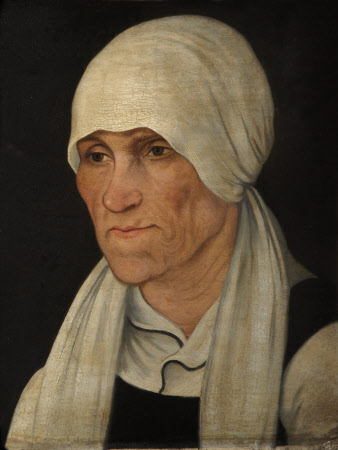Margaretha Luther
Robert Scott Tait (1816 - 1897)
Category
Art / Oil paintings
Date
1854
Materials
Oil on panel
Measurements
356 x 305 mm (14 x 12 in)
Order this imageCollection
Carlyle's House, London
NT 263716
Summary
Oil painting on panel, 'Margaretha Luther (c.1460-1531) (after Lucas Cranach the elder)', by Robert Scott Tait (1816-97), 1854.
Full description
The historian Thomas Carlyle (1795 - 1881) travelled to Germany in September 1852, where he toured to places with connections to people he admired. This included the Wartburg, a castle in Eisenach, where Martin Luther (1483 - 1546) translated the New Testament from ancient Greek into German in 1521-2. Carlyle was greatly interested in Luther, including him in a series of lectures published under the title On Heroes, Hero-Worship, and the Heroic in History in 1841. In these, Carlyle presented his theory that 'Universal History, the history of what man has accomplished in this world, is at bottom the History of the Great Men who have worked here.' After visiting the Wartburg, Carlyle wrote to his mother, Margaret, on 19 September, describing the room in which Luther lived and worked in the early 1520s and two portraits of Luther's mother and father, painted by Lucas Cranach the Elder (c.1472 - 1553): 'excel[en]t old Portraits … the mother particularly pious, kind, true and mother[ly]'. Joseph Neuberg (1806-67), a writer who acted as Carlyle's guide during his travels in Germany, wrote: 'It was touching to see Carlyle's reverence for all the relics of Luther, in whose room he said, "There is no more sacred spot in the whole earth for me to stand upon than this." … C. had promised his mother to trace out all footsteps of Luther.' [See fn. to TC-MAC, 19 Sept 1852, published in The Carlyle Letters Online.] Rosemary Ashton has speculated that Carlyle identified Luther's parents with his own (p. 325, Portrait of a Marriage), having mistakenly perceived Margaretha Luther (c. 1460 - 1531) as 'a noble old peasant woman'. Margaretha was in fact the daughter of a well-established burgher family, whose status was therefore rather different from that of Thomas' mother, Margaret Carlyle (1771 - 1853), the barely literate daughter of a poor farmer. In 1854, Robert Tait (1816-97) photographed both Jane and Thomas Carlyle and their home on Cheyne Row, and then set off for Germany. There, he too went to Eisenach, where he spent three days making copies of the Cranach paintings of Luther's parents. Tait gave these to Carlyle and received in response a letter in which Carlyle wrote, 'The Luther portraits are a decidedly welcome possession to me … They shall hang on my walls here; in daily sight of me...' [See TC-RST, 15 Jan 1855, published in The Carlyle Letters Online.] The companion painting of Martin Luther's father is NT 263717.
Provenance
Presented to Thomas Carlyle (1795-1881) by Robert Tait in 1854; returned to Tait (1816-97) on Carlyle's death; by descent to the artist's daughter, Mildred Scott Tait (1860 - 1950), who gave the portrait to Alicia Joanna Royston (1864 - 1933); by whom bequeathed to the National Trust.
Credit line
Carlyle’s House, Chelsea (National Trust)
Makers and roles
Robert Scott Tait (1816 - 1897), publisher after Lucas Cranach the Elder (Kronach 1472 - Weimar 1553), publisher
References
Ashton 2002: Rosemary Ashton, Thomas and Jane Carlyle: Portrait of a Marriage (2002), Chatto & Windus Carlyle 2023: Carlyle Letters Online (Duke University Press), 2023. https://carlyleletters.dukeupress.edu

